How Fashion Designers Can Use AI to Fuel Creativity, Not Competition

The emergence of artificial intelligence in virtually every sector has stirred existential panic in several professionals. It seems that AI can now generate creative designs, stories, and entire films–where does that leave human talent?
A 2024 Deloitte report found that many organizations remain hesitant to adopt AI, with approximately 75 percent citing data privacy and security as the most prominent ethical concerns.
At the same time, many well-known names in the fashion world have welcomed AI-based technologies, such as automated fabric cutting and using Gen AI to change sketches into designs.
Artificial intelligence can potentially encourage creativity in designers if only we view it as a partner, not an adversary.
Freeing Up Time for Unrestrained Thinking
In organizations that have implemented AI to speed up or automate their operations, time savings have been a significant advantage. According to a recent Thomson Reuters study, around 54 percent of the professionals surveyed report that the time-saving potential of AI excites them the most. AI applications can substantially reduce the time otherwise spent on repetitive administrative tasks.
The freed-up time can be a blessing for wearing your thinking caps and setting sail. You will likely be able to devote your energies to new designs and ideas when monotonous tasks don’t sap your energies. AI applications that can perform visual prototyping and marker-making for fabric utilization are perfect for enjoying this advantage.
Interestingly, how we utilize the freed-up time decides how lucrative AI adoption can be for us. A Harvard Business Review feature finds that 36 percent of people waste more than half the time saved by Gen AI applications. It goes against the hope that time savings can encourage people to learn new skills or connect with other professionals and their families.
Designers who incorporate AI into their daily work will require a more conscious approach to appreciate its merits. For instance, attending an industry event or taking a class to hone specific design skills, like color theory or sewing, can be excellent ways to make extra time rewarding.
Using AI to Enhance Your Digital Footprint
Many fashion designers have terrific ideas but don’t find the appropriate (or any) portal to showcase them. Everyone and their cat is on Instagram, and conducting private events and shows takes a lot of resources. AI can help you build a digital presence cost-effectively.
Hocoos notes that AI website generators can be used to create websites by providing only business-related answers as inputs. You can prepare a professional one without previous knowledge of website design or software development.
Similarly, AI tools can help you build portfolios quickly, allowing you to share your work with a large audience. Forbes reports some fashion brands have started using generative visuals for campaigns to eliminate the costs of actual models and shows.
This approach can increase your ROI and also reduce the time required to have your designs available in the market. Thanks to AI, a lack of technical skills needn’t limit your creative process anymore.
However, these AI applications require additional caution to maintain branding consistency and avoid IP conflicts.
Staying Aligned With Changing Customer Tastes
Another terrific bonus of AI in fashion is its ability to forecast trends and customer preferences. You can use data-driven AI applications to predict the hottest trends of the season and use these insights to tailor your designs.
The Guardian notes that using AI for trend prediction is best when combined with a creative angle and traditional analyst skills. For example, celebrity culture, emotions, and social media may play a meaty role in deciding and changing trends. The accuracy of the results generated by a tool may differ across edgy, trendy, and mainstream audiences.
Anyhow, the rise of artificial intelligence has made it possible for the regular designer to access insights that earlier could only be leveraged by big data geeks. You needn’t waste your time and effort in creating designs that may not be popular. It brings sustainability to a sector usually criticized for waste.
At the same time, you can use AI to design a strategy and marketing campaign to introduce something pathbreaking in the market. Who would have thought rhinestones and bucket hats would make a reappearance? (Well, someone certainly did.)
Final Word
Despite all the scrutiny AI receives, it seems that it can benefit the fashion sector in multiple ways. From enabling fashion startups to find audiences to reducing marketing costs, AI can offer several perks for designers and retailers.
From a broader perspective, AI has benefits for the entire fashion landscape. It can streamline the supply chain and facilitate fairer labor practices. It can help retailers understand the market well, from competitor pricing to seasonal fluctuations. These insights help make the sector sustainable by avoiding overstocking and unsuitable pricing that discourages customers.
Using AI with the caution that any disruptive technology demands can help you make the most of it.